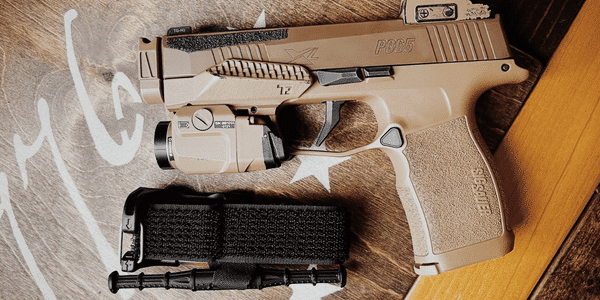Snakestaff Systems ETQ: A Tourniquet You’ll Actually Carry?
If you carry a firearm every day but don’t carry a tourniquet… YOU’RE WRONG. But we can change all of that with a new product that has been trending lately — the Snakestaff Systems ETQ.
When you walk out your door with a firearm to protect yourself and those around you by needing to potentially send rounds down range, do you not think there’s a potential for bullets to be returned in your direction? You’d be naïve to think otherwise. But not everyone carries an EDC tourniquet on them like this one we’re talking about. But why? It’s because they aren’t convenient to carry. What happens if you get hit in one of your arms or legs and have a massive bleed? If you had a Snakestaff Systems ETQ, you’d have a way of stopping the bleed.

Let’s face it, you already have a holster with a firearm and possibly a spare mag on your beltline, you don’t need anything else taking up more of that real estate. So, why not just shove a tourniquet in your pocket, right? Well, unless you want people to ask if you have a tourniquet in your pocket or if you’re just happy to see them, it’ll stick out worse than gun dick when you’re carrying in the appendix position with some holsters (having two bulges in your pants at the same time may cause some odd stares).
Related Article: EDC Medical Kit — More Important EDC Item Than a Firearm?
Could you simply carry an EDC tourniquet in your cargo pants pocket? Absolutely. But unless you walk around 24/7 like you’re GI Joe, you probably find yourself in jeans, shorts, etc. To solve this issue, the Snakestaff Systems ETQ was created.
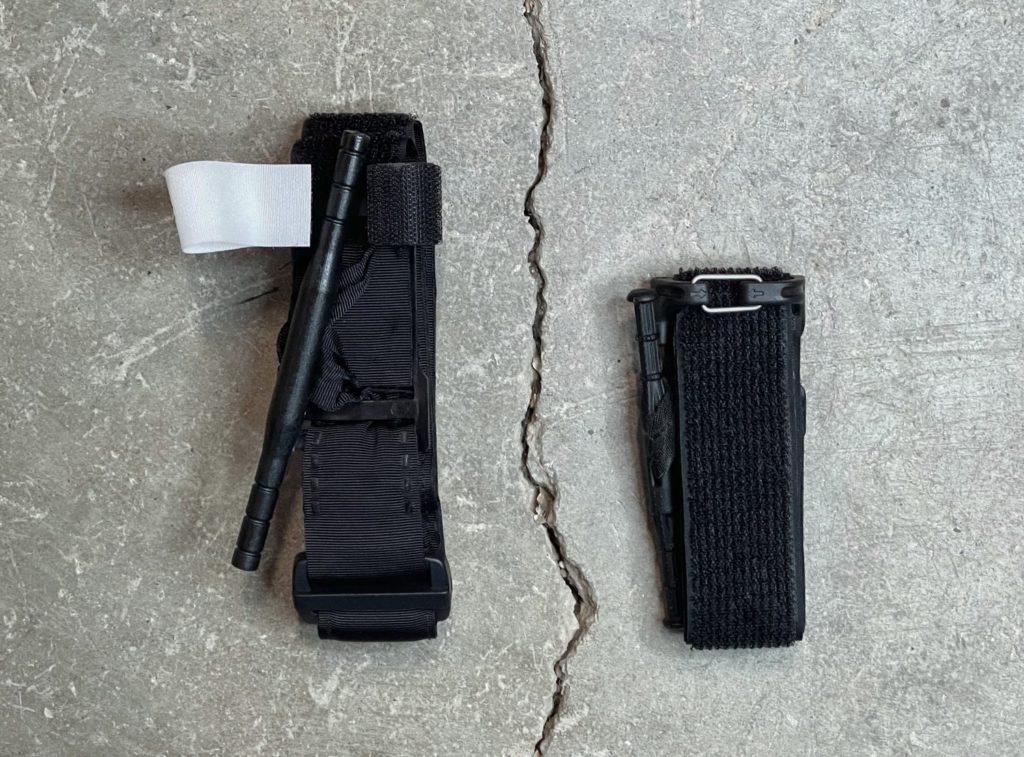
Disclaimer: All products and accessories mentioned in this article were purchased with my own money. No brand or company sent me anything for free, nor did they ask me to include their product(s) in this article. The thoughts and opinions in this article are solely mine based on my personal use, testing, and experience.
Table of contents
What is a Tourniquet and Why Would You Need One?
A tourniquet is a medical device used to temporarily stop or control the flow of blood through a blood vessel, typically an artery, by applying pressure around the limb or body part where bleeding is occurring. It is commonly used in emergency situations to prevent excessive bleeding, especially in cases of severe injuries or trauma.
Here are some key points about tourniquets and why they might be needed:
- Emergency Bleeding Control: Tourniquets are primarily used to control severe bleeding when other methods, such as direct pressure or wound dressing, are ineffective at stopping the hemorrhage.
- Trauma and Injuries: Tourniquets are often used in situations involving traumatic injuries, such as gunshot wounds, deep lacerations, or amputations, where rapid and significant blood loss can be life-threatening.
- Military and Combat: Tourniquets have a long history of use in military and combat scenarios. Soldiers may carry tourniquets as part of their first aid kits to address injuries sustained on the battlefield.
- Preventing Shock: By quickly halting blood loss, tourniquets help prevent a person from going into shock, which can occur when the body loses a significant amount of blood.
- Temporary Measure: Tourniquets should be considered a temporary measure to control bleeding until more advanced medical care is available. They should not be left in place for extended periods to avoid complications like tissue damage or limb loss.
- Proper Application: It’s crucial to apply a tourniquet correctly to be effective and minimize potential complications. This includes placing it high and tight above the bleeding site, ensuring it is secure but not so tight that it causes additional injury.
- Time Limit: In general, tourniquets should not be applied for more than two hours. Prolonged use can result in tissue damage and other complications.
- Medical Training: Proper training is essential for using tourniquets effectively and safely. Medical professionals, first responders, and individuals in high-risk environments often receive training on tourniquet application and wound care.
- Improvements in Design: Tourniquet technology has evolved over the years, with modern tourniquets designed to be easy to apply, adjustable, and releaseable, reducing the risk of complications.
- Civilian Use: While tourniquets were traditionally associated with military and medical professionals, there has been a growing emphasis on civilian access to tourniquets and training in recent years. Some organizations advocate for tourniquets as part of basic first-aid knowledge, especially in situations where rapid bleeding control is critical.

Overall, a tourniquet is a medical tool used to control severe bleeding in emergency situations, particularly those involving traumatic injuries. Properly applied tourniquets can be lifesaving, but their use should be limited to situations where other methods of bleeding control are inadequate, and they should be applied with care to minimize potential complications.
What is the Snakestaff Systems ETQ?
The Snakestaff Systems ETQ is an EDC tourniquet that is a much smaller and more compact package than your traditional SOF-T Wide or CAT tourniquets. The Snakestaff Systems ETQ Wide is 1.5” wide, while the Snakestaff Systems ETQ is only 1” wide.
Related Article: Should You Carry a CAT Tourniquet as Part of Your EDC?
Even the larger Snakestaff Systems ETQ Wide is 35% smaller than your standard tourniquet while still meeting the Committee of Tactical Combat Casualty Care (CoTCCC) requirements.
Click here to check out this tourniquet and look at the best prices.
These EDC tourniquets are a fantastic solution for those who need a slim profile in order to toss a tourniquet somewhere that space is limited, such as:
- Front pocket
- Back pocket
- Coat pocket
- Range bag
- Backpack or briefcase
- Fanny pack
- On a buttstock
- Glove box
- Center console
- Desk drawer
- Motorcycle bags
- And more!
Features of the Snakestaff Systems ETQ Wide and ETQ
(provided by the Snakestaff Systems website)
- Wider than ETQ™ at 1.5”
- 37.5” long
- Berry Compliant
- 35% smaller profile
- Non-water absorbent for maritime operations
- Easily concealed in pockets for low-vis ops
- Fits in pistol mag-holder
- Non-slip rigid windlass for bloody hands
- IR or red Chemlight available for ID of TQ placement on night ops
- K9 and child compatible
- Carabiner lock to secure windlass during patient transport
- Easy to read directions under stress
- Mil-Spec 4088 webbing
- UV-rated polymer and webbing

Features of the Snakestaff Systems ETQ
(provided by the Snakestaff Systems website)
- Width is 1”
- 37.5” long
- Berry Compliant
- Smaller profile and the wide
- Non-water absorbent for maritime operations
- Easily concealed in pockets for low-vis ops
- Fits in pistol mag-holder
- Non-slip rigid windlass for bloody hands
- IR or red Chemlight available for ID of TQ placement on night ops
- K9 and child compatible
- Carabiner lock to secure windlass during patient transport
- Easy to read directions under stress
- Mil-Spec 4088 webbing
- UV-rated polymer and webbing
Why Would You Want to Carry a Tourniquet Daily?
Carrying a tourniquet like the Snakestaff Systems ETQ daily might be considered if you have a specific need or context that requires immediate access to one. A tourniquet is a medical device used to stop severe bleeding by constricting blood flow to a limb or extremity.

Here are some reasons why someone might choose to carry a Snakestaff Systems ETQ tourniquet daily:
1. Occupational Hazards
If you work in a profession where there is a higher risk of traumatic injuries or accidents that could lead to severe bleeding, such as construction, law enforcement, or emergency medical services, carrying a Snakestaff Systems ETQ tourniquet could be part of your personal first aid kit.
2. Outdoor Activities
If you regularly engage in outdoor activities like hiking, camping, rock climbing, or biking in remote areas, having a tourniquet in your gear could be prudent in case of accidents that result in severe bleeding. The Snakestaff Systems ETQ is thin and compact to make transporting it daily a breeze.
3. Personal Safety Preparedness
Some individuals prioritize personal safety preparedness and carry items like tourniquets as part of their everyday carry (EDC) kit. This could include other medical supplies and tools that might be useful in emergencies.
4. Medical Conditions
If you have a medical condition that increases your risk of bleeding or if you’re taking medications that can affect blood clotting, you might choose to carry a tourniquet like the Snakestaff Systems ETQ to mitigate potential bleeding emergencies.

5. Response to Mass Casualties
In scenarios where you might be the first responder to a mass casualty event or accident, having a tourniquet on hand could enable you to assist others in need.
6. Bystander Intervention
In cases where you witness a severe injury or accident and can provide immediate help, having a tourniquet on your person like the Snakestaff Systems ETQ might save a life by stopping excessive bleeding until professional medical assistance arrives.
It’s important to note that carrying and using a tourniquet requires proper training. Incorrect use can lead to complications, and tourniquets should only be used as a last resort when direct pressure and other methods have failed to control bleeding. If you’re considering carrying a Snakestaff Systems ETQ, it’s advisable to seek proper training in its application and understand the risks and benefits associated with its use.
Why Would You Want The Snakestaff Systems ETQ Tourniquet?
As mentioned above, the obvious reason is to help preserve life in the event of a gunshot wound. Being able to quickly apply and secure a tourniquet can mean the difference between saving a life and one expiring.
Ease of use with the Snakestaff Systems ETQ is simple, and so long as you know how to apply a tourniquet, you can easily deploy it.
Both the SOF-T Wide and CAT tourniquet have a windlass clip that holds your windlass in place when you’re done tightening it on yourself or someone else. This locking mechanism helps prevent the windlass from turning and becoming loose. The difference with the Snakestaff Systems ETQ is that it utilizes a carabiner windlass lock that provides a greater degree of security and protection from the windless unhooking and taking pressure off the wounded arm or leg. The carabiner prevents the windlass from slipping out of the locking mechanism (a truly unique and ingenious feature).
Related Article: SAVE A LIFE — Medical Training w/ Iron Forge Consulting Group
The Snakestaff Systems ETQ also includes a truly innovative design that attaches a small chemlight to the side of the tourniquet. You may ask what the purpose is unless you get shot at a rave. When you apply the tourniquet and tighten it, the entire process causes the chemlight to break and glow. This helps give emergency responders a visual of where a casualty is and an immediate notification of where the tourniquet is on the body (which is especially useful and helpful at night).
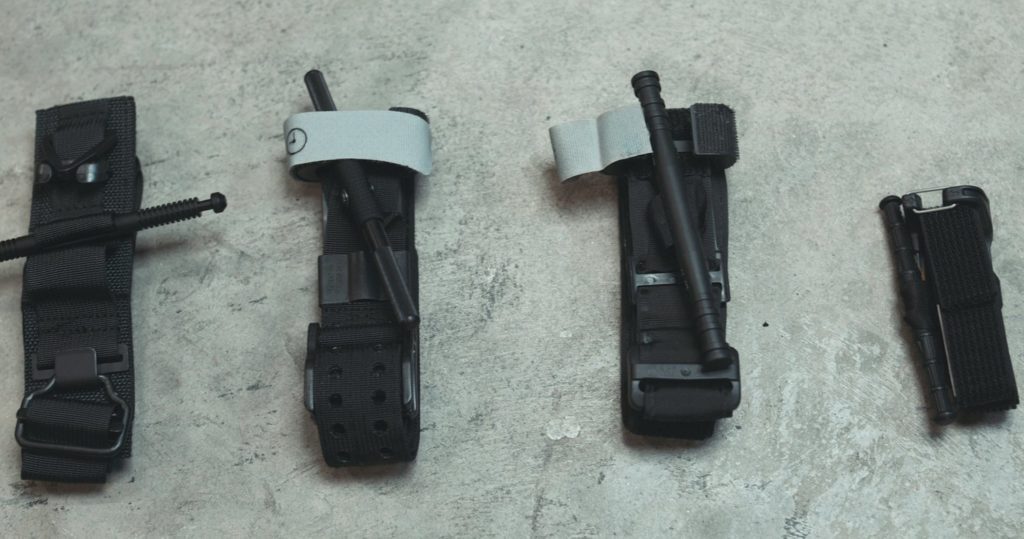
But the main reason and huge selling point for the Snakestaff Systems ETQ is the size of their EDC tourniquets. Personally, I can’t get over how thin they can be folded, as well as their overall size. The Snakestaff Systems ETQ is so small that it practically disappears wherever you put it. If you were to sit it next to a magazine, you’d find it comparable in size.
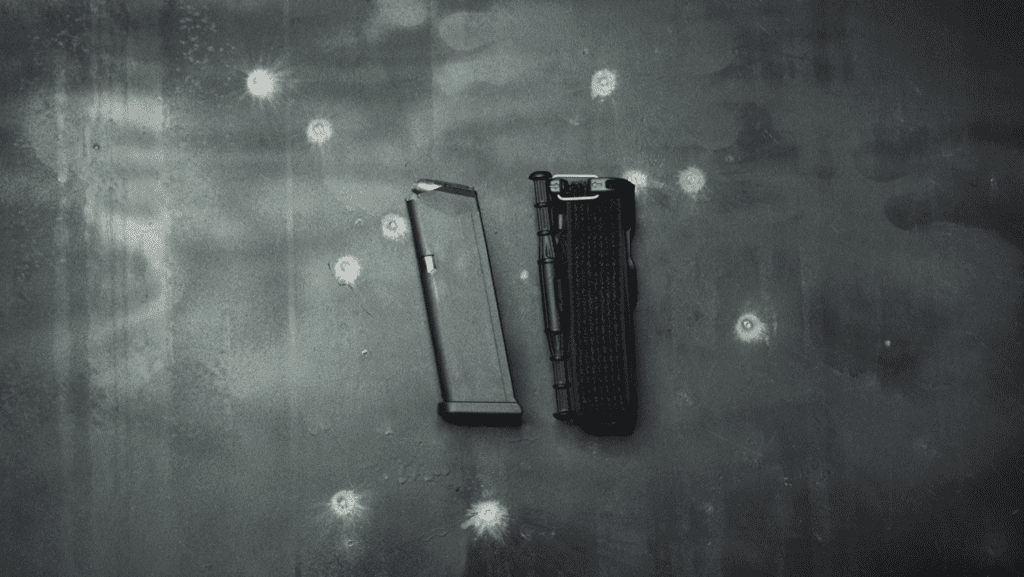
It should also be noted that if you save a life with your Snakestaff System ETQ, they will send you a free replacement, which I thought was really cool of them to offer.
Click here to check out the best prices on the Snakestaff System ETQ (both versions of the tourniquet).
Which ETQ is Right for You?
Truthfully, as much as I hate such an answer, it comes down to your personal application and needs. If you want to carry a wider tourniquet (for whatever reason), then go with the Snakestaff Systems ETQ Wide. If you want something insanely small that you can fit in a pocket for on-body carry and have no excuse not to carry an EDC tourniquet, then get yourself the Snakestaff Systems ETQ.
Personally, I love the Snakestaff Systems ETQ simply due to the size, but I also have a Snakestaff Systems ETQ Wide staged on one of my rigs. But with the smaller ETQ, I can toss it in my pocket and forget it’s even on me due to how small it is and how easy it is to carry and conceal (not that it would be the end of the world if someone noticed I was carrying a tourniquet).
Related Article: Jonathon Aldridge Talks EDC, TacMed, Training, and MORE!
I will say this… if you plan on carrying either version of the Snakestaff Systems ETQ in your pocket, I’d highly recommend you put it in something. The Velcro, when it shifts around, makes your typical Velcro noise, which, quite frankly, is annoying. Not only that, but the Velcro can stick to your clothing as well as anything in your pocket (or wherever you store it) can stick to the Velcro and not allow it to function properly.
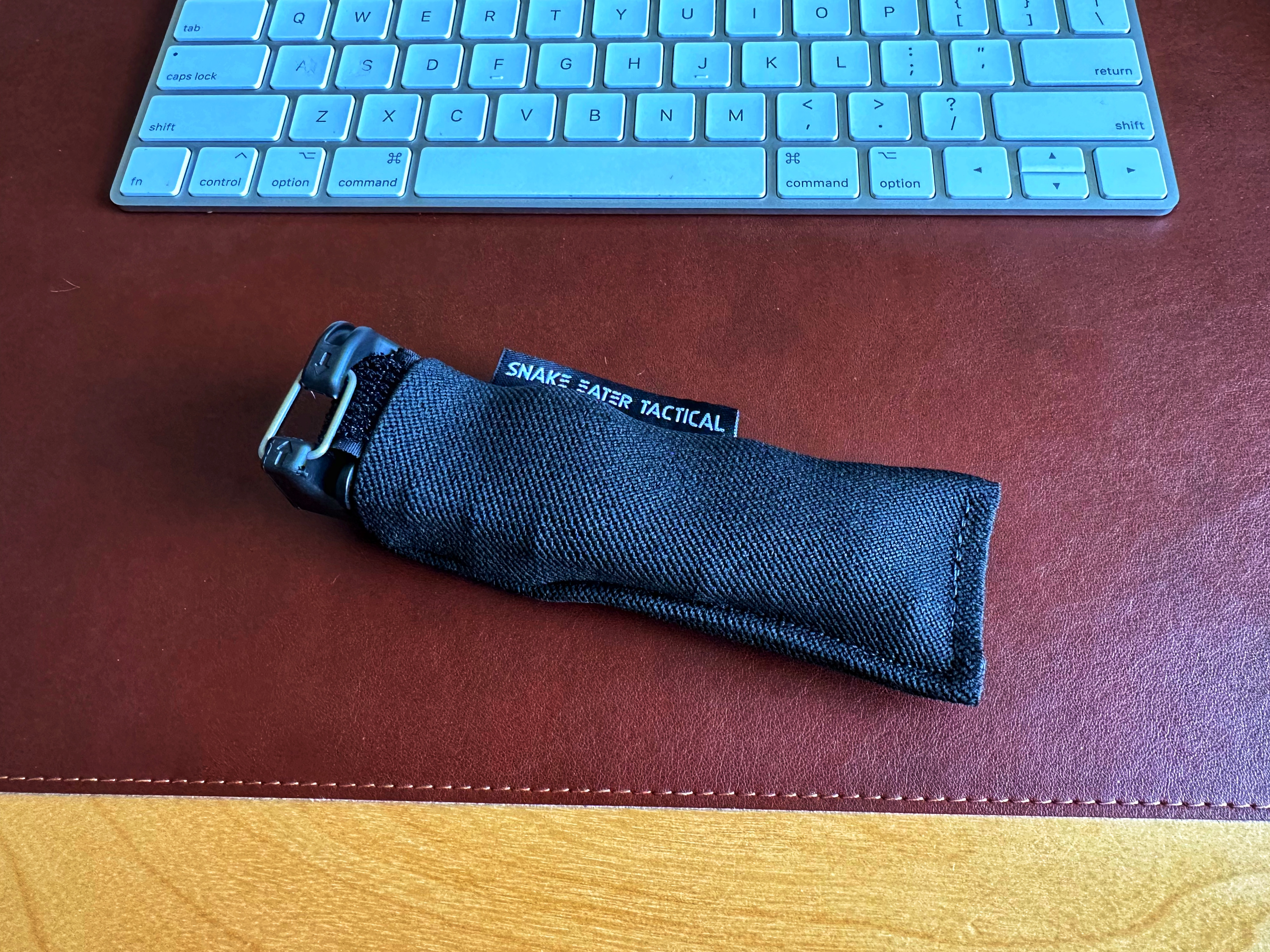
How do I solve this issue? I put my Snakestaff Systems ETQ in a magazine sleeve. I had a Snake Eater Tactical magazine sleeve lying around, and it fits perfectly into it. Snakestaff Systems also has their own SnakeSkin ETQ Sleeve if you prefer to purchase everything all at the same time.
But all in all, only you can decide which version of the Snakestaff Systems ETQ is right for you. Regardless, you’re going to be way happier carrying their EDC tourniquet over the SOF-T Wide or CAT tourniquet strictly based on the size and ease of carry. Again, if you carry a firearm, you should also carry a tourniquet.
It should also be noted that the Snakestaff Systems ETQ is in HIGH demand. It literally took me months to be able to order one, and I went to their website on the days they were updating inventory, only to find each time they sold out in around 30 minutes. So, if you want one (or multiple), be patient, and if you see them in stock, get it while you can!
Related Article: Don’t Be the Victim of a Deadly Encounter — Prepare NOW!
If You Need to Use the Snakestaff Systems ETQ, How Long Can It Stay on a Limb?
The length of time a tourniquet, such as the Snakestaff Systems ETQ, can safely stay on a limb is a matter of medical judgment and should be as short as possible. The general guideline is to use a tourniquet for the shortest duration necessary to control life-threatening bleeding. Prolonged use of a tourniquet can lead to complications, including tissue damage, nerve injury, and limb ischemia (lack of blood flow), which can ultimately result in limb loss.

Here are some key points to consider regarding the duration of tourniquet application:
- Temporary Measure: A tourniquet is a temporary measure to control bleeding until more advanced medical care can be provided. It should not be left in place for an extended period.
- Two-Hour Limit: In general, it is recommended that a tourniquet should not remain on a limb for longer than two hours. After two hours, there is an increased risk of complications, including tissue damage.
- Reassessment: While a tourniquet is in place, continuous monitoring and reassessment of the injured person’s condition are essential. If possible, release the tourniquet periodically (for a few seconds) to assess whether bleeding has stopped or slowed sufficiently without it.
- Communication with Medical Professionals: It’s crucial to communicate with medical professionals as soon as possible when a tourniquet is applied. They can provide guidance on when and how to release or adjust the tourniquet based on the individual’s condition and the availability of medical care.
- Proper Training: Anyone who may need to use a tourniquet in an emergency should receive proper training in its application and monitoring. Medical professionals and first responders are typically trained in tourniquet use and follow specific protocols.
- Improvised Tourniquets: Improvised tourniquets, such as belts or clothing, should only be used as a last resort and for a very brief period, as they can be less effective and more likely to cause injury.
- Tourniquet Selection: Modern tourniquets are designed with features that allow for easy adjustment and release. When available, these should be used as they offer more control over the pressure applied.
In summary, while a tourniquet like the Snakestaff Systems ETQ can be a lifesaving tool in emergencies, its use should be brief and closely monitored. It is essential to seek professional medical assistance as soon as possible to address the underlying injury and avoid complications associated with prolonged tourniquet application.
Additionally, it’s vital to have a dedicated training tourniquet to ensure you keep your new tourniquets fresh and ready to be applied in an emergency.
*Update on the Snakestaff Systems ETQ
I recently took a medical training class where one of the tourniquets tossed into the rotation was a Snakestaff Systems ETQ where it was going head-to-head with others like the CAT and SOF-T. Unfortunately, I noticed a few negatives of the Snakestaff Systems ETQ, one being a major issue. First off, due to how thin the straps are on the Snakestaff Systems ETQ when compared to the CAT and SOF-T, it rolled over on itself nearly every time we put it on a “casualty.”
This caused us to waste time when applying the ETQ due to us needing to unwrap it so that the strap would lay flat against the skin when tightening the strap and turning the windlass. Even more concerning was the fact that we had a failure of the Snakestaff Systems ETQ. One student was latching the windlass in the retention clasp when the clasp bend and failed. While the windlass didn’t pop out, the failure of the materials is not something you want in a real-life scenario with a casualty. Therefore, it’s my opinion that the CAT and SOF-T would still be better options when compared to the ETQ.
As a side note to close out this article, if you want to support our website and are in need of any tactical gear (or any product for that matter), anything you purchase using our links below will provide us with a small commission. We don’t charge for our free content and our goal is to keep it that way. We don’t have a Patreon account to put things behind a paywall, nor do we sell pics of our feet on OnlyFans. If you choose to use the links below and make a purchase (at no additional cost to you), we greatly appreciate your support as it helps us continue to publish free content (like this article) on our website:
- Optics Planet (use code SAS5 at checkout for 5% off)
- Amazon
And if you have a product you would like us to check out and potentially review, please contact us and let’s discuss.

And as always, go out and get the proper training needed to be proficient with your firearm(s) and EDC gear. I am not an instructor or tactical ninja, and I don’t pretend to be one on the weekends. I’m simply someone who seeks knowledge, improvement, and proficiency when it comes to self-defense and the ability to protect my family and those around me. You are your own first line of defense, seek the training of a certified and experienced instructor. If you are looking for an EDC tourniquet like the Snakestaff Systems ETQ, I hope you got some great insight based on my article. If you did, please feel free to share this article on your social media, with friends, or on your website. Thanks!


*Disclosure: This article may contain affiliate links or ads, which means we earn a small commission at no extra cost to you if you make a purchase through these links. These commissions help support the operation and maintenance of our website, allowing us to continue producing free valuable content. Your support is genuinely appreciated, whether you choose to use our links or not. Thank you for being a part of our community and enjoying our content.
PLEASE CONSIDER SHARING THIS ON YOUR SOCIAL MEDIA TO HELP OTHERS LEARN MORE ABOUT THIS TOPIC. SIMPLY CLICK BELOW!

